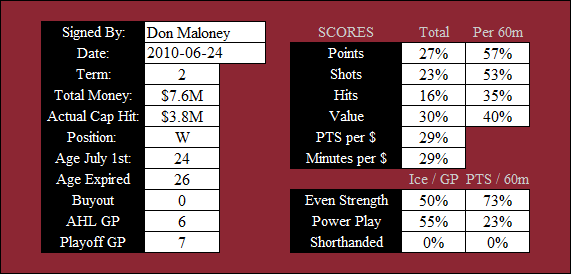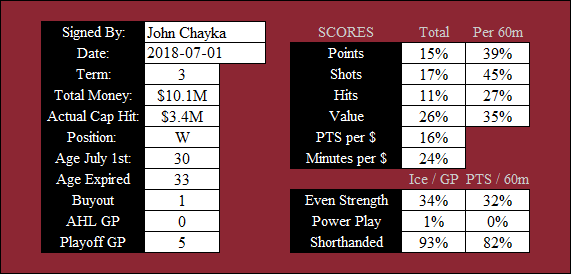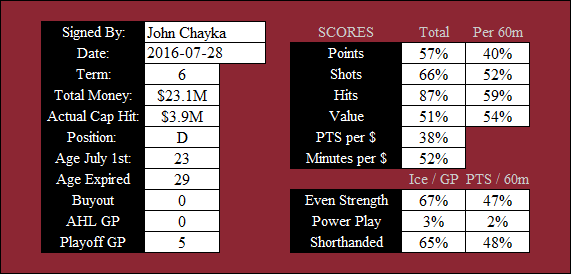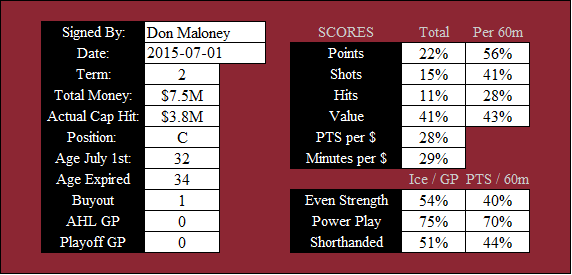The Arizona Salt Lake City Coyotes have long been a team that struggled financially, which has led their General Managers to be very reluctant handing out blockbuster commitments. This is reflected on their worst contracts list, as the inventory of bad investments starts to get thin towards the end. It’s a similar situation to the Ottawa Senators, where spending errors are constrained by budgetary limitations. Because this is a tight-budget team that often finds itself near the salary floor, they haven’t exactly been wasting piles of cash on the free agent market. They had one miraculous run to the conference final in 2012 and have been mostly shrouded in darkness since reaching that summit.
Don Maloney ran the team for nearly a decade before being replaced by “whiz kid” John Chayka, a former hero of the analytics community. The youngest GM in league history made a few errors, but his contribution to this list is still relatively small. If you want to argue that his administration was a failure, there are few glaring examples here. But it’s worth pointing out that there was also a lack of Chayka home runs on their best contracts list. They ranked 8th in buyout money, but a chunk of that was OEL, and Vancouver ate most of that money.
This was originally published in my 2020 book The Definitive Guide to Salary Mismanagement, and has now been updated with new contracts. I will continue to update each team’s list every summer going forward. The rule is that only active contracts can move up or down. Expired deals cannot pass each other (with a few exceptions). The book is still available on Amazon, though some of the stats on active contracts are now out of date. You may yet find it interesting because there were detailed stat graphics that you won't find here. One thing you won't find here are entry level contracts because they all come from the same cookie cutter and require less skill at the negotiating table.
1. Oliver Ekman-Larsson
Adjusted Cap Hit: $66.7M, $8.3M (avg)
Value Returned: $22.5M, $2.8M (avg)
% Earned: 34%
"He's a special player and person and we want to build our team around him. You can't win in this League without a star, elite defenseman and we're fortunate to have that in OEL. We look forward to many years ahead with him as our leader on and off the ice."
OEL had a $7M stat line the season before signing this contract, and initially it looked like a reasonable amount of money (though I’m sure there were detractors). It didn’t raise too many alarm bells with me, but I’m generally skeptical of 8-year terms to older players. He dropped down to a $6M player in year one and a $5M in year two before getting traded to Vancouver in a mutual salary dump, where OEL deteriorated even further. Chayka said he looked forward to many years ahead with OEL as the leader, but both would be gone long before this contract expired. Larsson’s play declined significantly with the Canucks, prompting the team to buyout the remainder of the deal.
2. Ed Jovanovski
Adjusted Cap Hit: $51.4M, $10.3M (avg)
Value Returned: $27.4M, $5.5M (avg)
% Earned: 53%
"He was the player we wanted. This is huge for our franchise."
Ed Jovanovski had become a cornerstone of the Canucks blueline as a heavy hitter and effective offensive contributor. He was scheduled to become an unrestricted free agent at age 30 and preliminary talks with the Canucks did not yield any results. Jovocop later disclosed his disappointment at the lack of a legitimate offer from Vancouver. Dave Nonis had to be concerned about Ed’s long-term durability. The injuries had already been piling up.
In year one Jovo earned a spot in the NHL All-Star game before an abdominal injury ended his season. In year two Jovo scored 51 PTS while earning another All-Star appearance. Afterwards is when the contract started breaking bad. His average ice time shrank each year, which is not unexpected on a 5-year deal given to a 30-year-old player. Injuries again dogged the final 2 years, including a disastrous 14 PTS in 50 GP in year five. But that didn’t stop the Florida Panthers from signing him to a 4-year extension at age 35 that you can read about on their worst contracts list.
3. Mike Ribeiro
Adjusted Cap Hit: $26.5M, $6.6M (avg)
Value Returned: $7.9M, $2.0M (avg)
% Earned: 30%
"Mike is an elite playmaker who has exceptional vision and creativity on the ice. He has tremendous offensive skills with great patience with the puck.”
"Mike had some real behavioural issues we felt we could not tolerate going forward"
Mike Ribeiro scored at an 84-point pace during the lockout shortened 2013 season before hitting the UFA market at age 33. After listening to offers from around the league, the dynamic pivot decided he wanted to stay in Arizona. The cash strapped Coyotes made a big splash to entice the offensive catalyst, taking a risk with the 4-year term given the age.
Ribeiro had a very disappointing season, scoring 47 PTS in 80 GP before Don Maloney bought out the remaining term. What had to happen for a team bleeding money to buy out an expensive contract getting nothing in return? There were some shenanigans in his personal life that when compounded with a substantial production drop, made his continued employment untenable. Yet his career wasn’t over, as he moved on to Nashville where his scoring output rebounded.
4. Nick Boynton
Adjusted Cap Hit: $14.8M, $4.9M (avg)
Value Returned: $4.1M, $1.4M (avg)
% Earned: 28%
"Nick is a tough, skilled defenseman who will add a physical presence to our blueline. He is a great addition to our solid young corps of defensemen."
Nick Boynton peaked offensively in 2004 when he notched 30 PTS, then played in England during the lockout. When he returned to the Bruins, that offensive upside had disappeared, prompting Boston to trade him to the Coyotes for Paul Mara and a 3rd round pick. Mike Barnett had to be gambling that scoring dip was temporary when making him this generous salary offer.
The only thing Boynton was good at in Arizona was taking penalties. The Coyotes knew they weren’t buying offense when they made this purchase, but they had to be hoping they were getting a defenseman who could at least approach 20 minutes per game. That never materialized, as his ice time dropped considerably upon arrival in Arizona.
They managed to dump the contract on the Florida Panthers as part of the Ballard for Jokinen trade, where Nick’s offensive output improved considerably. That earned him another deal with Anaheim, albeit for half the salary.
5. Mike Smith
Adjusted Cap Hit: $40.0M, $6.7M (avg)
Value Returned: $21.6M, $3.6M (avg)
% Earned: 54%
"It was probably a little longer than I wanted the deal and less money than maybe Mike wanted, and when both sides were unhappy, it was probably a good deal"
After a career year in 2012, Mike Smith came back to Earth in 2013, providing league average goaltending at age 30. This did not stop the team from signing him to a 6-year deal at age 31 on the eve of free agency. Don Maloney gave Smith extra term to lower the annual cap hit.
In years two, three, four of this ticket, Smitty had 48 wins, 81 loses, 2.95 GAA, .910 SV%, and zero playoff games. That’s not elite goaltending. Perhaps you can blame it on the team, but there were still some good defensemen playing in front of him. He was shipped off to Calgary with 2 years remaining for a good return and played well for the Flames until he was injured and never completely recovered.
Smith wasn’t terrible and not every season received a failing grade. This was merely an overpayment that never translated into team success.
6. Wojtek Wolski
Adjusted Cap Hit: $10.3M, $5.1M (avg)
Value Returned: $3.6M, $1.8M (avg)
% Earned: 35%
“He is a talented offensive player who performed extremely well for us last season down the stretch and led our team in goals during the playoffs.”
The Coyotes traded 8th overall draft pick Peter Mueller (whose career still had promise at that point) to acquire Wojtek Wolski, who scored 18 PTS in 18 GP for the remainder of the 2010 season in Arizona, earning himself a decent 2-year extension. He was worth every penny (and probably more) for what he had produced that season, but the door was about to slam shut.
Don Maloney picked a bad time to invest in the 24-year-old Wolski, who saw his production nose dive in year one. They managed to trade him to the Rangers for a 3rd round pick before the bottom really fell out, which was a smart move. Wolski signed one more contract for close to the league minimum, played 27 more NHL games, then returned to Europe and had success in the KHL.
7. Jamie McGinn
Adjusted Cap Hit: $11.0M, $3.7M (avg)
Value Returned: $3.7M, $1.2M (avg)
% Earned: 33%
“Jamie is a big, physical, power forward who scores goals and plays a gritty style. He will be a great addition to our roster.”
Jamie McGinn delivered a career year with 39 PTS in 84 GP the season before becoming an unrestricted free agent at age 27. John Chayka paid a fair price for the stat line, unfortunately McGinn was unable to sustain that apex, plummeting down to 17 PTS in 72 GP in year one as a bottom six winger.
Year two hadn’t even started when Chayka shipped him to Florida for Jason Demers. McGinn did get a bump in production after the trade, but that would be short-lived, as the final year was a failure. Back surgery before training camp all but ruined his season, possibly his career, as he ended up in the AHL. He never signed another NHL contract.
8. Lauri Korpikoski
Adjusted Cap Hit: $12.1M, $3.0M (avg)
Value Returned: $6.1M, $1.5M (avg)
% Earned: 51%
"Lauri is an intelligent, two-way forward, an effective penalty-killer and an excellent skater. We are excited to have him back with us in Phoenix this season."
Lauri Korpikoski reached his career apex in 2011 when he ripped 19 goals and 40 PTS, but was unable to recapture his scoring touch after returning from the 2013 lockout. That did not deter the Coyotes from paying him like a 40-point player on a 4-year term.
Korpikoski’s point production stayed very consistent throughout this contract, but was still only returning 60 cents of value for each dollar invested. It was his ice time however that steadily decreased as he approached age 30. The Coyotes were able to trade him to Edmonton for Boyd Gordon, who scored 4 PTS in 65 GP and was out of the NHL a year later. The Oilers bought out the remainder of Korpikoski’s contract after just one season.
9. Michael Grabner
Adjusted Cap Hit: $10.4M, $3.5M (avg)
Value Returned: $2.7M, $0.91M (avg)
% Earned: 26%
"Everyone knows my game is based on speed and skating. I would say I'm a shoot-first kind of guy. They have a lot of good playmakers on the roster. I'm just going to try to use my speed and open up some space for them.”
“I’ve never felt as good about the organization as I do today”-
Michael Grabner had just completed a 27-goal season split between the Devils and Rangers before becoming an unrestricted free agent at age 30. The speedster would find a new home in Arizona at nearly precisely the price this type of asset should cost at the same term of his comparables average. This was inked the same day as OEL and Hjalmarsson also received extensions (hence why Chayka was so excited).
They might have paid for a 27-goal scorer, but that’s not what arrived in the desert. A serious eye injury in year one might have been partially to blame for the eventual decline, but by year two he had become a regular healthy scratch, playing 4th line minutes when he did crack the line-up. The team bought out the final season.
10. Zbynek Michalek
Adjusted Cap Hit: $7.4M, $3.7M (avg)
Value Returned: $1.9M, $0.97M (avg)
% Earned: 26%
"When I was leaving, I never really closed any doors. I was hoping that maybe it was possible that I'll be back on the team."
Zbynek Michalek was heading towards unrestricted free agency when the Coyotes shipped him off to St Louis as a rental, in exchange for a prospect. Zbynek decided to return to the desert on July 1st for a small pay cut, that in retrospect should have been a large pay cut.
The Czech defenseman’s ice time plunged by nearly 4 minutes per game in year one when he scored 7 PTS in 70 GP. That didn’t get any better in year two, as he cleared waivers and was sent to the AHL for the majority of the season. That’s far too much money to spend if you want to bolster the blueline of your farm team. Zbynek returned to Czechoslovakia when this pact expired.
11. Derek Morris
Adjusted Cap Hit: $19.7M, $6.6M (avg)
Value Returned: $12.0M, $4.0M (avg)
% Earned: 61%
"They are both extremely talented and we feel, have their best years ahead of them."
Derek Morris netted a career high 48 PTS in 2003 with Colorado and simply accepted his qualifying offer at the conclusion of the lockout. When Mike Barnett solicited his signature on a 3-year extension, the GM probably felt like he was getting a bargain.
Morris may have very well been a bargain if not for the collapse of his offensive numbers, scoring 25 PTS in 82 GP in year one. He wasn’t a bad defenseman, averaging 24 PTS per 82 GP, with 21 minutes per game of ice time, he was simply overpaid for his services. This was like paying $6.5M for a player worth $4M. Morris took a pay cut on a 1-year deal to play in Boston when this concluded.
12. Connor Murphy
Adjusted Cap Hit: $24.6M, $4.1M (avg)
Value Returned: $17.9M, $3.0M (avg)
% Earned: 73%
“At only 23, Connor has established himself as a very good NHL defenseman. He’s a great skater, a fierce competitor and he has an excellent work ethic. We look forward to him taking the next step and having him on our blue line for many years to come.”
On most teams, Connor Murphy would have been forced to take a short-term bridge deal at a smaller salary when his ELC expired. Chayka decided to pay a little extra in the near-term to presumably buy unrestricted years at a reduced price, but the experiment lasted only one season before he was traded to Chicago to acquire Hjalmersson.
Murphy’s first season in Chicago was a disaster, as his ice time dropped to 16.4 minutes per game, much too low for his rate of compensation. His production and deployment would eventually rebound, to where this pact wasn’t looking too bad by year four. He closed it out respectably, but we’ll still rank it here as bad because there was some money wasted early in the tenure and this team doesn’t have worse deals to choose from.
13. Antoine Vermette
Adjusted Cap Hit: $8.7M, $4.3M (avg)
Value Returned: $5.0M, $2.5M (avg)
% Earned: 58%
“It’s never a bad thing to add Stanley Cup winners into your locker room, especially with some of the young players we’re going to have around, so this is really a great way to end the day”
Antoine Vermette hit the UFA market after the Coyotes traded him to Chicago as a rental where he won the Stanley Cup. The 32-year-old center made it all the way to July 1st before deciding on a return to Arizona; a city state that he never really wanted to leave in the first place and was very emotional when the trade happened.
Antoine proceeded to score the exact same number of PTS as the previous season, then was bought out. It’s a little strange that he provided exactly the same production that was deemed insufficient to retain his employment. One thing that did change that summer was the General Manager, as John Chayka took over and ousted the veteran from his roster.
14. Niklas Hjalmarsson
Adjusted Cap Hit: $10.2M, $5.1M (avg)
Value Returned: $2.6M, $1.3M (avg)
% Earned: 26%
Niklas Hjalmarsson was a gladiator for the Chicago Blackhawks 3 Stanley Cup championships, but he was eventually shipped off to the desert for a younger and slightly cheaper Connor Murphy. Niklas must have liked Arizona, as he signed another contract at a more expensive price. Management decided to give the 32-year-old defensive specialist a pay raise, but the bad news was he did not have much gas left in the tank, battling injuries in both his last 2 seasons. Those years of gladiatorial battles in the coliseum took a toll that should have been predictable.
15. Dmitrij Jaskin
Adjusted Cap Hit: $3.3M, $3.3M (avg)
Value Returned: $0.78M, $0.78M (avg)
% Earned: 24%
Dmitri Jaskin left the NHL to spend two seasons in the KHL, where he magically discovered his scoring touch. I have not broken down any video to explain this sudden sniping, but it might be as simple as nobody ever encouraged him to shoot or put him in a position to succeed offensively. That 2nd year, he scored 38 goals, 10 more than second place. The Coyotes bought the hype hook, line, and sinker, paying him a salary worth nearly triple his best season in the NHL. When Jaskin returned to the big show, he was worse than when he left. Turns out tearing up the KHL is no guarantee of NHL success. Go figure…
16. Shane Doan
Adjusted Cap Hit: $26.4M, $6.6M (avg)
Value Returned: $22.3M, $5.6M (avg)
% Earned: 84%
“I chose to stay with the Coyotes because I am committed to winning here, not anywhere else, and I love living and playing in the Valley. This is my home and this is my team.”
Shane Doan had defied the aging curve for a power forward in his early 30s, making the team comfortable enough to extend a 4-year deal at age 35, which is always an enormous risk. The captain scored 48 PTS per 82 GP, which isn’t terrible, but at that price was unquestionably too expensive. There was a premium paid for his loyal long-time service.
To make matters worse, the Coyotes did not get a single playoff game from this ticket, producing a disappointing return on their investment (though he did earn 84% of his cap hit and received a passing grade by my metrics, I’m just running out of bad Coyotes contracts). He still had more left in the tank at age 39 and signed for 1 more year after this. The man was unquestionably a warrior.
17. Georges Laraque
Adjusted Cap Hit: $4.3M, $2.1M (avg)
Value Returned: $1.6M, $0.78M (avg)
% Earned: 36%
"The Coyotes have made a lot of great moves this summer and we will be a very competitive team next season. I'm looking forward to playing for Wayne Gretzky."
Georges Laraque played a very limited role in Edmonton’s run to the Stanley Cup final, but still earned himself a nice little 2-year deal as an unrestricted free agent. Laraque was still regarded as one of the most feared enforcers in the league, and was able to cash in on that reputation. Though it might be worth pointing out, year one he scored 24 PTS, which is tied for the most PTS scored in a season for a player averaging under 10 minutes per game. He even received power play time, though most of his production came at even strength. I had to run a diagnostic when I saw his even strength PTS per 60m sore at 66%.
The big winger’s production actually improved in year one while still playing under 10 minutes per game, which helped the Coyotes trade him to Pittsburgh for a nice return (3rd round draft pick), where his contribution diminished. Georges was on the roster as the Penguins advanced to the Cup final, but was often a healthy scratch in the post-season. His career wasn’t over yet, and you can read more about it on the Montreal Canadiens worst contracts list.
18. Shane Doan
Adjusted Cap Hit: $5.5M, $5.5M (avg)
Value Returned: $2.1M, $2.1M (avg)
% Earned: 37%
It was previously mentioned that Shane Doan signed a 1-year deal to end his NHL career, and this was it. Doaner took a big step backwards, as his point production fell from 47 to 27 with more games played. Thankfully for the Coyotes it was only a 1-year treaty, otherwise it would have been much higher up the list. The Yotes were not a playoff team at this point and likely needed to pay him this much money to reach the floor, so there wasn’t much harm done with this overpayment.
19. Antti Raanta
Adjusted Cap Hit: $13.3M, $4.4M (avg)
Value Returned: $5.3M, $1.8M (avg)
% Earned: 40%
The Arizona Coyotes sent Tony DeAngelo and a first round pick to the Rangers for Antti Raanta and Derek Stepan, with the hope that Raanta could be a solid #1 goalie when freed from the shadow of Henrik Lundqvist. His first year in Arizona (under his old Rangers contract) was sensational, posting a .922 SV% in 47 games, earning himself a substantial pay raise. The problem was more an inability to stay healthy than poor play. He did play well in year two, posting a .917 SV% in 38 games, but he only managed 12 and 18 GP in the other two seasons. When this expired, he departed for Carolina and half as much money.
20. Petr Prucha
Adjusted Cap Hit: $3.5M, $1.7M (avg)
Value Returned: $2.4M, $1.2M (avg)
% Earned: 69%
“He is a former 30-goal scorer and an emerging young offensive talent who competes hard every night. We look forward to Petr bringing a combination of speed and skill to our lineup.”
Prucha produced the best season of his entire career as a rookie in New York, as the production started a downward trend for the rest of his NHL tenure. The Czech winger was shipped to Arizona at the 2009 trade deadline in his fourth season. The decline was already on display, so the Coyotes managed to retain him at a reduced salary. Year one was decent, but Petr was buried in the AHL in year two and never played in the NHL again.
























